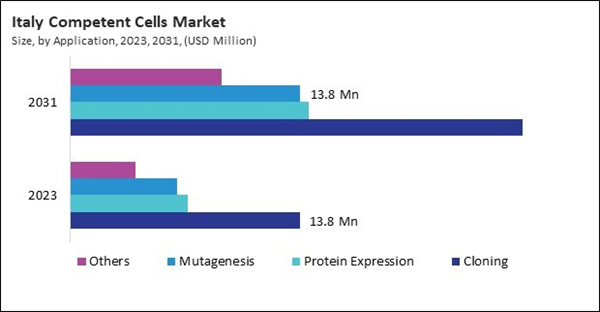The Germany market dominated the Europe Competent Cells Market by Country in 2023, and is forecast to continue being a dominant market till 2031; thereby, achieving a market value of $248.4 million by 2031. The UK market is exhibiting a CAGR of 6.6% during (2024 - 2031). Additionally, The France market is projected to experience a CAGR of 8.7% during (2024 - 2031).
These cells are used in the biopharmaceutical and biotechnology industries to produce recombinant proteins in therapeutic drugs, vaccines, and industrial enzymes. They provide a robust platform for scaling protein production, ensuring high yields, and maintaining protein quality and functionality. With the advent of technologies like CRISPR/Cas9, these cells are indispensable for genetic engineering and genome editing applications.
Adopting these cells in the biotechnology and life sciences industries is influenced by several key market dynamics, reflecting their critical role in advancing scientific research, biopharmaceutical development, and industrial applications. The biopharmaceutical sector is a major driver of these cell adoption. As the demand for biologics, including therapeutic proteins, monoclonal antibodies, and vaccines, continues to rise, so does the need for efficient and reliable protein expression and production systems. These cells provide a foundational platform for producing recombinant proteins in diagnostics and therapies.
Belgium’s pharmaceutical industry increasingly focuses on biopharmaceuticals, including therapeutic proteins, monoclonal antibodies, and vaccines. As a result, Belgium is home to 29 of the world’s top 30 pharmaceutical companies, including important subsidiaries of major U.S. companies such as Johnson and Johnson and Pfizer. The expansion of biopharmaceutical manufacturing in Belgium leads to a higher demand for these cells, particularly strains optimized for protein expression and high yield production. This trend boosts market growth for competent cell suppliers catering to the biotechnology and pharmaceutical sectors. Furthermore, The UK life sciences sector is advancing biopharmaceutical development, focusing on innovative therapies, vaccines, and personalized medicine. According to the UK Government, the number of life sciences firms in the UK has steadily risen since the 2008/09 fiscal year, reaching 6,850 in 2021/22. These companies operated from 7,910 sites across the UK, marking a 1% increase compared to the previous year. The turnover generated by UK life sciences businesses amounted to £108.1 billion in 2021/22, reflecting a 13% rise from the turnover of £95.9 billion (in 2021/22 prices) recorded in 2020/21. Hence, the increasing pharmaceutical industry and life science sector in the region are driving the market's growth.
List of Key Companies Profiled
- Thermo Fisher Scientific, Inc.
- Merck KGaA
- Agilent Technologies, Inc.
- Bio-Rad Laboratories, Inc.
- Promega Corporation
- New England Biolabs, Inc.
- Qiagen N.V
- Hoffmann-La Roche Ltd.
- Takara Bio Inc. (Takara Holdings Inc.)
- Lonza Group Ltd. (Capsugel)
Market Report Segmentation
By Type- Chemically Competent Cells
- Electrocompetent Cells
- Ultracompetent Cells
- Cloning
- Protein Expression
- Mutagenesis
- Others
- Pharmaceutical & Biotechnology Companies
- Academic & Research Institutes
- Others
- Germany
- UK
- France
- Russia
- Spain
- Italy
- Rest of Europe
Table of Contents
Companies Mentioned
- Thermo Fisher Scientific, Inc.
- Merck KGaA
- Agilent Technologies, Inc.
- Bio-Rad Laboratories, Inc.
- Promega Corporation
- New England Biolabs, Inc.
- Qiagen N.V
- F. Hoffmann-La Roche Ltd.
- Takara Bio Inc. (Takara Holdings Inc.)
- Lonza Group Ltd. (Capsugel)
Methodology

LOADING...









